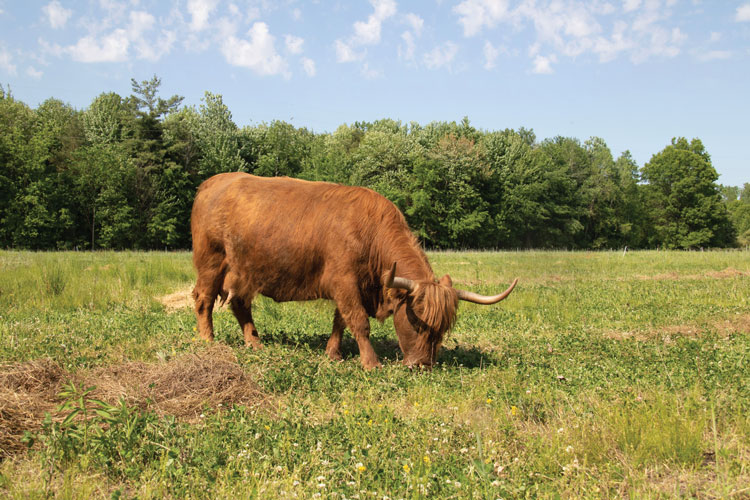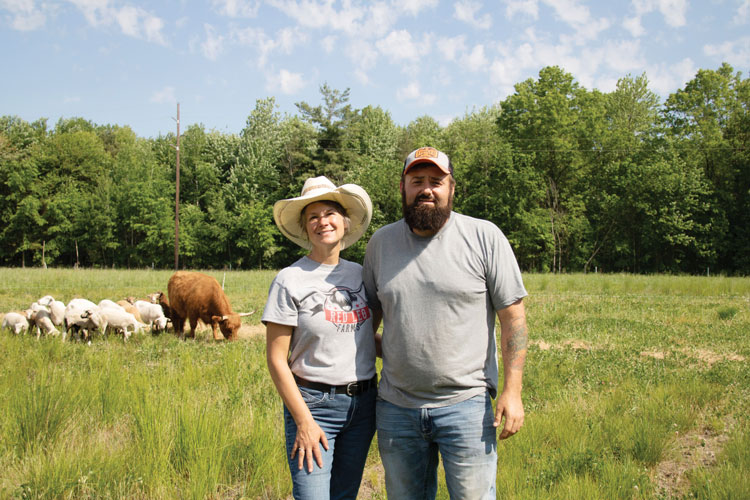
If you are familiar with the television series, “Extreme Makeover: Home Edition,” you will recall how every episode begins with a team of carpenters, painters, and plumbers gutting a dilapidated house from the inside out. Fast forward to the end of the show and the host yells “Move! That! Bus!” into a megaphone to reveal a new version of the old home with updated roofing, siding, flooring, and furniture.
In 2018, Nick and Annie Rodgers found themselves starring in their own version of the show when they acquired a 70-acre farm in Montrose, Mich. Instead of using a hammer and nails to repair a ramshackled building, though, the Rodgerses used livestock as their tool to transform the degraded cropland into productive pastures.
When Nick and Annie met, neither of them had much farming experience. He grew up participating in rodeos and later served in the U.S. Army, and she had a background in business and sold real estate. Even so, the couple envisioned having a small herd of beef cattle and growing alfalfa, so they jumped at the chance to purchase their property when it went up for sale.
The farm was previously used to grow corn and soybeans, but it had become unkempt over time. The Rodgerses found piles of trash, pieces of scrap metal, and the occasional vehicle battery hiding among the weeds, not to mention a heap of tires buried under a thicket of grape vines. They spent the first few months on the property picking up debris and eventually prepared the seedbed to plant alfalfa in the spring of 2019. Their dream of harvesting high-quality hay was almost a reality until they encountered some unruly rain.
“After we drilled the alfalfa — and just as it was starting to come up — we got 4 1/2 inches of rain in less than 18 hours,” Annie shook her head, still in disbelief. “Everything floated away or died. We were just like, ‘What are we going to do now?’”
The answer came to them while they were watching a documentary about regenerative agriculture. “That started us down a rabbit hole of looking into grazing rather than making hay, which we didn’t have any more money to put toward inputs for anyway,” Annie said.
What started out as an economic decision evolved into an environmental one as the couple shifted their mindset to adaptive grazing and holistic management. They attended pasture walks, enrolled in grazing schools, and continued to watch videos and listen to podcasts about regenerative agriculture to pinpoint the practices they wanted to pursue.
Today, Red Leg Farms encompasses roughly 130 acres of owned and rented land, including several pastures in various stages of renovation. The Rodgerses have established a robust mix of grasses and legumes in their fields for their sheep and cattle, and their colorful cowherd is just as diverse as their forage base. They strive to share their story with others by hosting pasture walks of their own, and they sell beef and lamb direct-to-consumer, giving customers an inside look at how food gets from farm to table.
Reseeding with round bales
The Rodgerses admit their first attempt at grazing livestock was somewhat of a failure. After their alfalfa seedlings washed away, Nick broadcast seeded orchardgrass and perennial ryegrass in the field. He also planted some cover crops to protect patches of bare soil.
The couple experimented with bale grazing that winter. They made temporary paddocks by driving T-posts into the ground and adorning them with aluminum wire — a tedious routine they engaged in nearly every day. Then they set out large square bales and scattered hay by hand. “I felt like a flower girl at a wedding,” Annie laughed from under a wide-brimmed hat. “If you looked at the field from above, it probably looked like a checkerboard with flakes of forage spread around.”
To alleviate some of this manual labor, the Rodgerses bought step-in posts and polywire to make creating temporary paddocks less of a chore. They also invested in equipment to move and unroll large round bales.
Nick buys late-maturity, first-cutting hay from to ensure reseeding from bale grazing is successful, and he works with several sellers so not all of his hay comes from the same farm. Results from a long-term monitoring study with the Noble Research Institute and Michigan State University show one of the pastures at Red Leg Farms contains 17 different forage species.
“I want to get as many different species of plants out there as I can possibly get,” Nick said. “We have some clover, teff grass, bromegrass, orchardgrass, Kentucky bluegrass — the list is a mile long. It has all been replanted with hay.”
Livestock begin to strip graze pastures in the spring, starting with the 70-acre area at the Rodgerses’ home farm. Then Nick and Annie parade the animals across the road to a 22-acre field in the early stages of renovation that they lease from a neighbor before rotating the sheep and cattle through three other rented pastures that are all within a few miles.
Nick allots livestock new forage every day, but he monitors plant growth to determine how far to move the polywire forward. He also assesses pasture conditions to pace grazing rotations. One rotation takes 30 to 35 days at the start of the season when grass growth is rapid, whereas the same rotation will last about 90 days in the summer to prevent cattle from overgrazing when it is hot and dry.
Access to mineral supplements is key to balance forage consumption, and Nick strategically situates mineral tubs in pastures to influence grazing behavior. For example, placing a tub on the side of the field opposite from the waterer encourages more grazing traffic throughout the field and results in a better distribution of manure.
The couple currently moves a portable water cart for their livestock from pasture to pasture, refilling it every three days. They plan on installing a permanent water system using a pressurized underground waterline someday.

Bovine brand loyalty
Red Leg Farms is home to several cattle breeds, including Scottish Highland, South Poll, Hereford, and British White Park. A flock of hair sheep also graze alongside the cattle, serving as the clean-up crew for less desirable forage species. The Rodgerses aim to maintain a stocking density of 35 animal units, which equates to approximately 25 cattle plus 20 to 30 sheep.
Despite the eclectic group of grazing animals, Nick and Annie built their brand on the backs of their Scottish Highland cattle. The distinctive features of this breed — long, wavy hair and a broad set of horns — are depicted in their business logo, which they believe stands out to customers and generates greater interest in their meat sales.
One consequence of the charming characteristics of Scottish Highland cattle is that their horns are too wide to fit in some processing facilities. This made it more difficult to find locker space, so the Rodgerses resolved to introduce different breeds to their herd to keep up with demand. They also started breeding their Scottish Highland cows to South Poll bulls since some of the offspring do not have horns.
Red Leg Farms sell cuts of lamb and freezer beef in halves and wholes. Sheep and cattle are 100% grass-fed and grass-finished, and the Rodgerses advertise that they do not administer preventative treatment to their livestock. They believe these attributes attract a niche market of health-conscious consumers who are willing to pay higher prices for their products.
“Our customers choose to buy from us even though it might be more expensive because they know our animals were raised with lower inputs,” Annie asserted. “If an animal gets sick, we will treat it, but then it will be marketed differently.”
In addition to communicating what’s in their products, Nick and Annie like to show customers what’s on their farm. When people come to pick up orders, the couple invite them on a walking tour of the property to explain the forage system, the grazing rotation, and the positive effects their management has on their animals and their land.
“For as much as we want people to be educated about how we graze livestock, I also want people to know where their food comes from. That has really made the difference for me,” Annie said.
Giving back
The goal of regenerative agriculture is to rehabilitate farming systems by engaging in practices that improve soil health, encourage biodiversity, and benefit the environment overall. Little did Nick know before he and Annie established Red Leg Farms that repairing pastures and caring for livestock would be a form of recovery for himself, too.
Nick was medically retired from the Army after serving in combat and being diagnosed with post-traumatic stress disorder. When he and Annie set out to start farming, he thought raising cattle in a feedlot and making hay would be a good way to get back on his feet. Rather, he found a greater purpose in life by looking through a more regenerative lens.
“Taking care of the animals, watching the ground, and improving my grasses, forage quality, and plant diversity has really been good for my mental health and well-being,” Nick said, reflecting on the positive change.
The couple have an overwhelming sense of gratitude for farming that they want others to experience as well. Although renovating their own pastures is an ongoing endeavor, they are training to become associate educators with the Savory Institute. The organization’s mission is to regenerate the world’s grasslands through holistic management, and after realizing the advantages of this approach for themselves, the couple want to support beginning graziers who are doing the same.
“One of the things that we have made a priority is teaching others about why or how to think differently about their own operations,” Annie said. “Finishing our training and becoming educators will hopefully help us do that.”
On the next episode of “Extreme Makeover: Pasture Edition,” you might find the Rodgerses somewhere other than Montrose. They are open to the idea of raising livestock in a more brittle environment one day to expand their expertise in adaptive grazing. Whether that be on arid rangeland out West or in a completely different country, Nick and Annie are eager to apply their newfound knowledge wherever they can.

